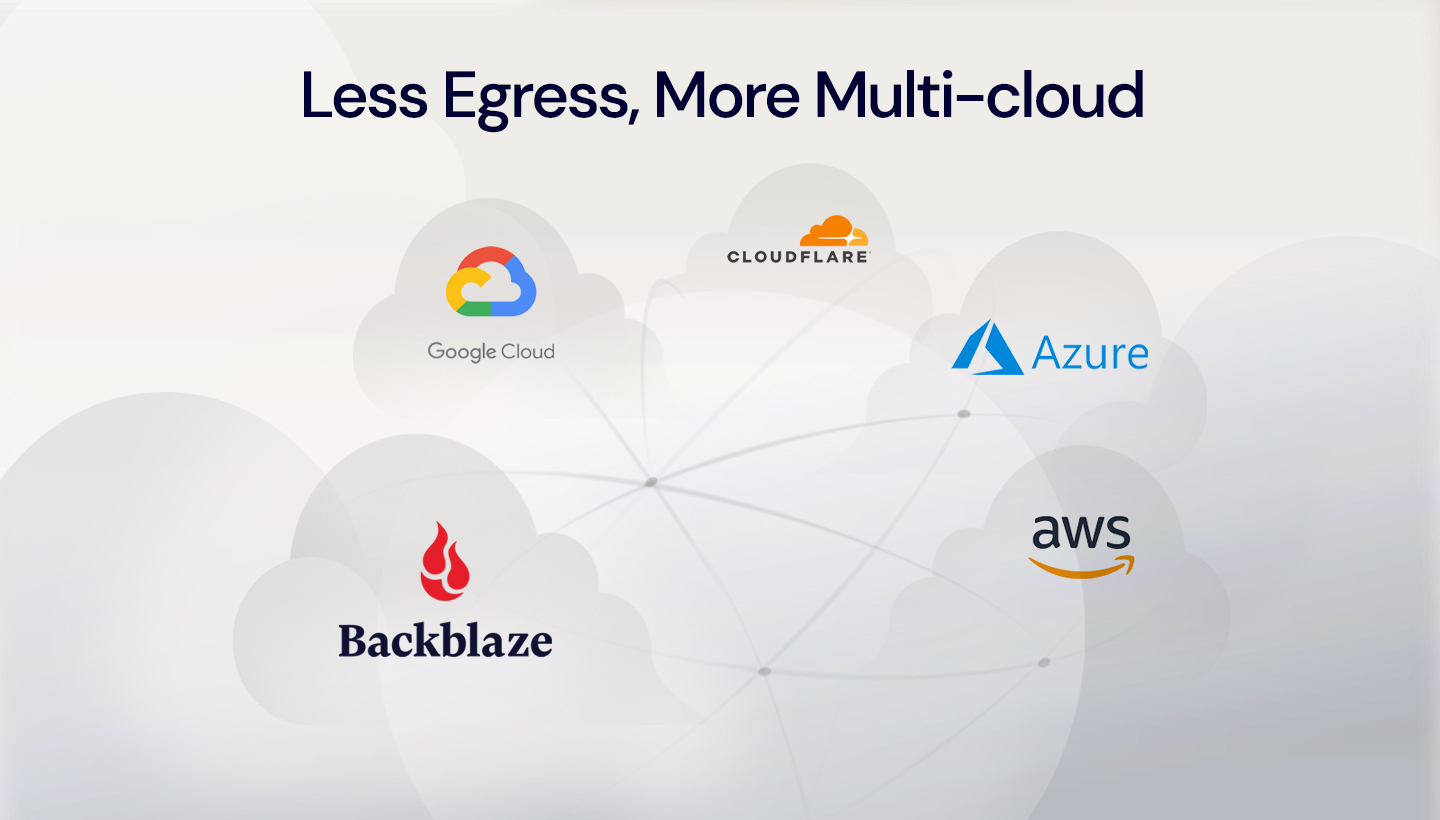
Imagine a world where you can move data freely wherever you want, a world where you can use best-of-breed cloud providers to get the ideal service, optimize cost for your overall infrastructure, and build redundancy into your cloud platform—all without fear of lock-in.
In short, a world with lower egress fees.
Are lower egress fees a cure-all for the world’s problems? No, but it sure would make life easier for millions of companies. We believe in a multi-cloud world powered by low or zero egress fees. Today, we’re digging into what that means.
The Need for Multi-cloud
As companies seek to avoid vendor lock-in, get the best from different clouds, and provide redundancy for mission critical data, multi-cloud deployments are becoming more commonplace. According to Frost & Sullivan’s 2020 Global Cloud User Survey, respondents indicated growing from 43% adoption of multi-cloud in 2020 to 84% planned adoption of multi-cloud in 2022.
Multi-cloud deployments represent the future of cloud computing, and unlocking that potential means low or no egress fees.
The Case Against High Egress Fees
Cloud companies charge egress fees when customers want to move their data out of the provider’s platform. Existing diversified cloud providers such as Amazon charge egregiously high egress fees that make it expensive for customers to use multi-cloud infrastructures and therefore lock customers in to their services. These walled gardens hamper innovation and long-term growth.
The bottom line: high egress fees are a direct impediment to a multi-cloud future.
The Benefits of a Multi-cloud Future
The demand for multi-cloud infrastructure is rising and the case against high egress fees is gaining traction because a robust, multi-cloud system offers clear benefits:
- Best-of-breed providers: Specialized cloud providers are focusing on key parts of the tech stack and offering the best services. Multi-cloud deployments enable customers to pick the best parts for their environment.
- Disaster recovery: One of the biggest advantages of operating a multi-cloud environment is to achieve redundancy and plan for disaster recovery in a cloud-native deployment. If one public cloud suffers an outage, customers have mechanisms in place to direct their applications to failover to a second public cloud.
- Cost optimization: Challenger companies (Shameless plug: that’s us!) can offer better pricing through innovation and a focus on specialized use cases than the traditional diversified clouds—Amazon, Google, and Microsoft.
- Freedom from vendor lock-in: Many companies initially adopted one of the existing diversified cloud providers like Amazon or Google because they were the only game in town, but later felt restricted by their closed systems. Companies like Amazon seek to lock customers in with proprietary services. Adopting a multi-cloud infrastructure with interoperable providers gives these customers more negotiating power and control over their cloud deployments.
- Unconflicted partners: Some customers find themselves in direct competition with companies like Amazon. Shifting their cloud usage to independent, unconflicted partners in a multi-cloud deployment means they don’t have to worry about how their data might be used against them, and they’re not spending money to support a direct competitor.
One Small Step in the Right Direction
After a recent Amazon announcement, we’re one small, incremental step closer to that future where egress fees don’t hold you back. Last week, they announced an expansion of their free tier for data transfer to the internet from 1GB per month to 100GB per month. Fees above the free tier will remain the same, starting at $0.09/GB for 100GB to 9.999TB of data transfer out per month.
To understand this change in action, here’s a quick example. Previously, a customer egressing 100GB per month was paying $9 per month in egress fees. Now, they’ll pay nothing, and customers egressing above 100GB per month will get a $9 per month discount. (It’s worth noting that egress begins to be discounted beyond 9.999TB per month, but you’d be paying $900/month before that discount would take effect.)
Groundbreaking, it is not. But it’s a move that indicates Amazon is bowing to industry pressure that calls their egress fees exactly what they are—exorbitant and egregious.
While it’s not going to be a payday for most customers, we still believe this is a good thing. Even a small reduction in fees could enable a customer to consider a multi-cloud solution when they hadn’t before. For example, let’s say a customer stores 1TB of data in Amazon S3, and they egress out 100GB per month. Egress used to cost them $9, now it’s free. That $9 per month savings could be used to store a backup copy of their 1TB of data (And then some!) in Backblaze B2 Cloud Storage, allowing them to achieve double the redundancy without changing their overall cloud spend. They get the peace of mind of knowing they’re better protected against data loss for the same cost.
Lower Egress = A Better, Multi-cloud World
At Backblaze, we’ve always believed it’s good and right to enable customers to readily use their data. Our egress fees stand at just $0.01/GB, and we’re proud to be a founding member of Cloudflare’s Bandwidth Alliance. Backblaze also waives egress fees to Fastly, Vultr, and other forward-thinking cloud companies, and we cover the cost of data migrations above 10TB through our Cloud to Cloud Migration service.
Lower egress fees support a flexible, open ecosystem on which customers are free to build multi-cloud deployments that level up their businesses. As a leading independent cloud storage platform, it’s part of our commitment to simplify the process of storing and using data. We’re just happy to see companies like Amazon starting to follow suit.




